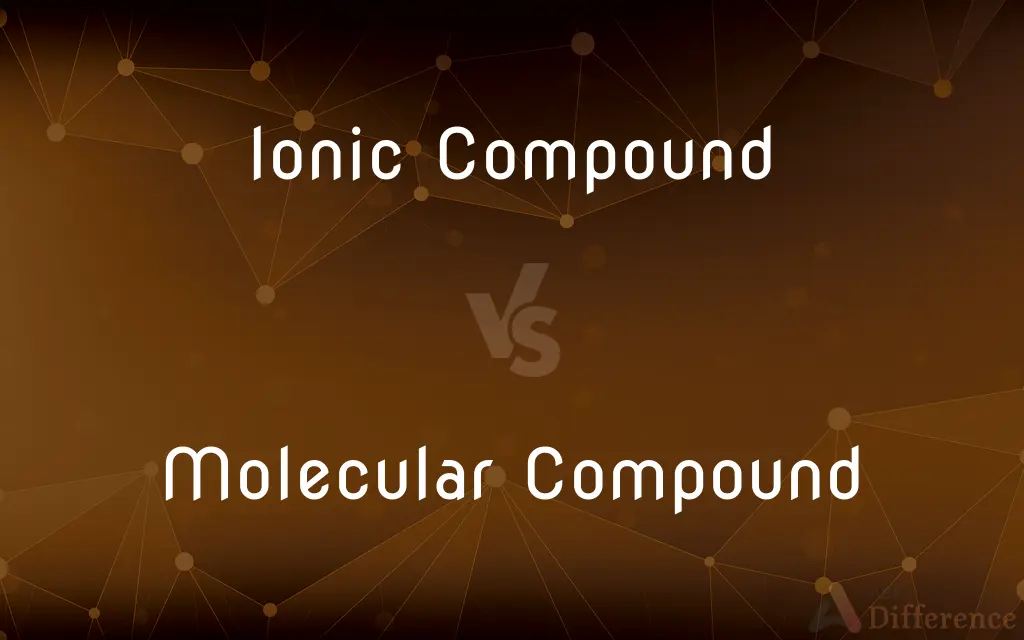Ionic Compound vs. Molecular Compound — What's the Difference?
By Tayyaba Rehman — Published on January 30, 2024
Ionic compounds are formed by the electrostatic attraction between ions, typically a metal and a non-metal, while molecular compounds consist of molecules formed by covalent bonds between non-metals.

Difference Between Ionic Compound and Molecular Compound
Table of Contents
ADVERTISEMENT
Key Differences
Ionic compounds are chemical compounds comprising ions held together by electrostatic forces termed ionic bonding. They usually consist of a metal and a non-metal. Molecular compounds, or covalent compounds, are formed when two or more non-metals share electrons, creating covalent bonds.
In ionic compounds, the metal loses electrons to become a positively charged cation, while the non-metal gains these electrons to become a negatively charged anion. In molecular compounds, the atoms share electrons, and no significant electron transfer occurs.
Ionic compounds typically have high melting and boiling points due to the strong ionic bonds. Molecular compounds generally have lower melting and boiling points as the intermolecular forces are weaker than ionic bonds.
Ionic compounds often dissolve in water and conduct electricity when dissolved or melted, due to the movement of ions. Molecular compounds usually do not conduct electricity, as they do not have charged particles that can move freely.
Ionic compounds are usually crystalline solids at room temperature, forming a crystal lattice structure. Molecular compounds can exist in various states (solid, liquid, gas) at room temperature, with diverse structures depending on the molecules involved.
ADVERTISEMENT
Comparison Chart
Bonding
Electrostatic attraction between ions
Covalent bonds between atoms
Constituent Elements
Typically a metal and a non-metal
Non-metals
Melting and Boiling Points
High due to strong ionic bonds
Lower due to weaker intermolecular forces
Electrical Conductivity
Conductive when dissolved or melted
Generally non-conductive
Physical State at Room Temp
Crystalline solids
Varies (solid, liquid, gas)
Compare with Definitions
Ionic Compound
Conducts electricity when dissolved.
Ionic compounds like calcium chloride conduct electricity in solution.
Molecular Compound
Shares electrons between atoms.
Molecular compounds like carbon dioxide involve sharing of electrons.
Ionic Compound
Crystalline solids at room temperature.
Most ionic compounds, like table salt, are crystalline.
Molecular Compound
Various states at room temperature.
Molecular compounds can be gases, like oxygen.
Ionic Compound
Comprises a metal and a non-metal.
Potassium iodide is an ionic compound.
Molecular Compound
Formed by covalent bonds between non-metals.
Water is a molecular compound.
Ionic Compound
Formed by electrostatic attraction between ions.
Sodium chloride is a common ionic compound.
Molecular Compound
Usually non-conductive.
Molecular compounds like sugar do not conduct electricity.
Ionic Compound
High melting and boiling points.
The ionic compound magnesium oxide has a high melting point.
Molecular Compound
Lower melting and boiling points.
The molecular compound methane has a low boiling point.
Common Curiosities
What are some examples of ionic compounds?
Sodium chloride (table salt) and potassium bromide.
Why do ionic compounds have high melting points?
Due to the strong attraction between the ions in the compound.
Can molecular compounds conduct electricity?
Generally, no, because they do not have free ions.
What creates the bond in an ionic compound?
The electrostatic attraction between positively and negatively charged ions.
How are molecular compounds formed?
By the sharing of electrons between non-metal atoms.
Do molecular compounds dissolve in water?
Some do, but they do not dissociate into ions like ionic compounds.
Are covalent or ionic bonds stronger?
Generally, ionic bonds are stronger.
Can molecular compounds be polymers?
Yes, many polymers are molecular compounds.
Why are ionic compounds typically crystalline?
They form a regular lattice structure due to the ionic bonds.
Are all molecular compounds gases at room temperature?
No, they can be solids, liquids, or gases.
Can ionic compounds be formed with two non-metals?
No, they typically involve a metal and a non-metal.
What determines the state of a molecular compound at room temperature?
The strength of the intermolecular forces between its molecules.
Do molecular compounds have high boiling points?
Usually, they have lower boiling points compared to ionic compounds.
Why do ionic compounds conduct electricity when dissolved?
The ions become free to move and carry electrical current.
Do all ionic compounds form salts?
Many, but not all, ionic compounds are considered salts.
Share Your Discovery

Previous Comparison
Olde English Bulldogge vs. English Bulldog
Next Comparison
Theatrical Versions vs. Unrated VersionsAuthor Spotlight
Written by
Tayyaba RehmanTayyaba Rehman is a distinguished writer, currently serving as a primary contributor to askdifference.com. As a researcher in semantics and etymology, Tayyaba's passion for the complexity of languages and their distinctions has found a perfect home on the platform. Tayyaba delves into the intricacies of language, distinguishing between commonly confused words and phrases, thereby providing clarity for readers worldwide.














































